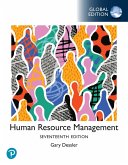- Broschiertes Buch
- Merkliste
- Auf die Merkliste
- Bewerten Bewerten
- Teilen
- Produkt teilen
- Produkterinnerung
- Produkterinnerung
Quantitative Analysis for Management helps you develop a real-world understanding of business analytics, quantitative methods, and management science. It does this by using mathematical model building, tangible examples, and computer applications. You're first introduced to models and then you apply those models using step-by-step, how-to instructions and software.
Andere Kunden interessierten sich auch für
![Framework for Marketing Management, A, Global Edition Framework for Marketing Management, A, Global Edition]() Philip KotlerFramework for Marketing Management, A, Global Edition57,99 €
Philip KotlerFramework for Marketing Management, A, Global Edition57,99 €![Operations Management: Sustainability and Supply Chain Management, Global Edition Operations Management: Sustainability and Supply Chain Management, Global Edition]() Jay HeizerOperations Management: Sustainability and Supply Chain Management, Global Edition125,99 €
Jay HeizerOperations Management: Sustainability and Supply Chain Management, Global Edition125,99 €![Retail Management, Global Edition Retail Management, Global Edition]() Barry BermanRetail Management, Global Edition125,99 €
Barry BermanRetail Management, Global Edition125,99 €![Entrepreneurship and Effective Small Business Management, Global Edition Entrepreneurship and Effective Small Business Management, Global Edition]() Norman ScarboroughEntrepreneurship and Effective Small Business Management, Global Edition104,99 €
Norman ScarboroughEntrepreneurship and Effective Small Business Management, Global Edition104,99 €![Human Resources Management, Global Edition Human Resources Management, Global Edition]() Gary DesslerHuman Resources Management, Global Edition112,99 €
Gary DesslerHuman Resources Management, Global Edition112,99 €![Essentials of Entrepreneurship and Small Business Management, Global Edition Essentials of Entrepreneurship and Small Business Management, Global Edition]() Norman ScarboroughEssentials of Entrepreneurship and Small Business Management, Global Edition129,99 €
Norman ScarboroughEssentials of Entrepreneurship and Small Business Management, Global Edition129,99 €![Quantitative Equity Portfolio Management, Second Edition: An Active Approach to Portfolio Construction and Management Quantitative Equity Portfolio Management, Second Edition: An Active Approach to Portfolio Construction and Management]() Ludwig ChincariniQuantitative Equity Portfolio Management, Second Edition: An Active Approach to Portfolio Construction and Management86,99 €
Ludwig ChincariniQuantitative Equity Portfolio Management, Second Edition: An Active Approach to Portfolio Construction and Management86,99 €-
-
-
Quantitative Analysis for Management helps you develop a real-world understanding of business analytics, quantitative methods, and management science. It does this by using mathematical model building, tangible examples, and computer applications. You're first introduced to models and then you apply those models using step-by-step, how-to instructions and software.
Hinweis: Dieser Artikel kann nur an eine deutsche Lieferadresse ausgeliefert werden.
Hinweis: Dieser Artikel kann nur an eine deutsche Lieferadresse ausgeliefert werden.
Produktdetails
- Produktdetails
- Verlag: Pearson Education Limited
- 14 ed
- Seitenzahl: 608
- Erscheinungstermin: 1. Juni 2023
- Englisch
- Abmessung: 276mm x 216mm x 25mm
- Gewicht: 1196g
- ISBN-13: 9781292459080
- ISBN-10: 1292459085
- Artikelnr.: 67263771
- Herstellerkennzeichnung
- Libri GmbH
- Europaallee 1
- 36244 Bad Hersfeld
- gpsr@libri.de
- Verlag: Pearson Education Limited
- 14 ed
- Seitenzahl: 608
- Erscheinungstermin: 1. Juni 2023
- Englisch
- Abmessung: 276mm x 216mm x 25mm
- Gewicht: 1196g
- ISBN-13: 9781292459080
- ISBN-10: 1292459085
- Artikelnr.: 67263771
- Herstellerkennzeichnung
- Libri GmbH
- Europaallee 1
- 36244 Bad Hersfeld
- gpsr@libri.de
Barry Render is Professor Emeritus, the Charles Harwood Distinguished Professor of Operations Management, Crummer Graduate School of Business, Rollins College, Winter Park, Florida. He received his BS in Mathematics and Physics at Roosevelt University and his MS in Operations Research and his PhD in Quantitative Analysis at the University of Cincinnati. He previously taught at George Washington University, the University of New Orleans, Boston University, and George Mason University, where he held the Mason Foundation Professorship in Decision Sciences and was Chair of the Decision Science Department. Dr. Render has also worked in the aerospace industry for General Electric, McDonnell Douglas, and NASA. Dr. Render has coauthored 10 textbooks published by Pearson, including Managerial Decision Modeling with Spreadsheets, Operations Management, Principles of Operations Management, Service Management, Introduction to Management Science, and Cases and Readings in Management Science. More than 100 articles by Dr. Render on a variety of management topics have appeared in Decision Sciences, Production and Operations Management, Interfaces, Information and Management, Journal of Management Information Systems, Socio-Economic Planning Sciences, IIE Solutions, and Operations Management Review, among others. Dr. Render has been honored as an AACSB Fellow and was named twice as a Senior Fulbright Scholar. He was Vice President of the Decision Science Institute Southeast Region and served as software review editor for Decision Line for 6 years and as Editor of the New York Times Operations Management special issues for 5 years. From 1984 to 1993, Dr. Render was President of Management Service Associates of Virginia, Inc., whose technology clients included the FBI, the US Navy, Fairfax County, Virginia, and C&P Telephone. He is currently Consulting Editor to Financial Times Press. Dr. Render has taught operations management courses at Rollins College for MBA and Executive MBA programs. He has received that school's Welsh Award as leading professor and was selected by Roosevelt University as the 1996 recipient of the St. Claire Drake Award for Outstanding Scholarship. In 2005, Dr. Render received the Rollins College MBA Student Award for Best Overall Course, and in 2009 was named Professor of the Year by full-time MBA students. Ralph Stair is Professor Emeritus at Florida State University. He earned a BS in Chemical Engineering from Purdue University and an MBA from Tulane University. Under the guidance of Ken Ramsing and Alan Eliason, he received a PhD in Operations Management from the University of Oregon. He has taught at the University of Oregon, the University of Washington, the University of New Orleans, and Florida State University. He has taught twice in Florida State University's Study Abroad Program in London. Over the years, his teaching has been concentrated in the areas of information systems, operations research, and operations management. Dr. Stair is a member of several academic organizations, including the Decision Sciences Institute and INFORMS, and he regularly participates in national meetings. He has published numerous articles and books, including Managerial Decision Modeling with Spreadsheets, Introduction to Management Science, Cases and Readings in Management Science, Production and Operations Management: A Self-Correction Approach, Fundamentals of Information Systems, Principles of Information Systems, Introduction to Information Systems, Computers in Today's World, Principles of Data Processing, Learning to Live with Computers, Programming in BASIC, Essentials of BASIC Programming, Essentials of FORTRAN Programming, and Essentials of COBOL Programming. Dr. Stair divides his time between Florida and Colorado. He enjoys skiing, biking, kayaking, and other outdoor activities. Michael E. Hanna is Professor Emeritus of Decision Sciences at the University of HoustonClear Lake (UHCL). He holds a BA in Economics, an MS in Mathematics, and a PhD in Operations Research from Texas Tech University. For more than 25 years, he has been teaching courses in statistics, management science, forecasting, and other quantitative methods. His dedication to teaching has been recognized with the Beta Alpha Psi teaching award in 1995 and the Outstanding Educator Award in 2006 from the Southwest Decision Sciences Institute (SWDSI). Dr. Hanna has authored textbooks in management science and quantitative methods, has published numerous articles and professional papers, and has served on the Editorial Advisory Board of Computers and Operations Research . In 1996, the UHCL Chapter of Beta Gamma Sigma presented him with the Outstanding Scholar Award. Dr. Hanna is very active in the Decision Sciences Institute (DSI), having served on the Innovative Education Committee, the Regional Advisory Committee, and the Nominating Committee. He has served on the board of directors of DSI for 2 terms and also as regionally elected vice president of DSI. For SWDSI, he has held several positions, including president, and he received the SWDSI Distinguished Service Award in 1997. For overall service to the profession and to the university, he received the UHCL President's Distinguished Service Award in 2001. Trevor S. Hale is a Professor of Business Analytics in the Mays School of Business at Texas A&M University with an emphasis in teaching. He received a BS in Industrial Engineering from Penn State University, an MS in Engineering Management from Northeastern University, and a PhD in Operations Research from Texas A&M University. He was previously on the faculty of the University of HoustonDowntown, Ohio UniversityAthens, and Colorado State UniversityPueblo. Dr. Hale is a third-generation professor following his father at Penn State and his father's father at UTEP. Dr. Hale has spent 5 summers as an Office of Naval Research Senior Faculty Fellow. He spent the summers of 2009, 2011, 2013, 2017, and 2022 performing energy security/cyber security research for the US Navy at Naval Base Ventura County in Port Hueneme, California. Dr. Hale has published dozens of articles in the areas of operations research and quantitative analysis in journals such as the International Journal of Production Research, the European Journal of Operational Research, Annals of Operations Research, the Journal of the Operational Research Society, and the International Journal of Physical Distribution and Logistics Management, among several others. He teaches business analytics courses at Texas A&M University. He is a senior member of both the Decision Sciences Institute and INFORMS.
1. Introduction to Quantitative Analysis
2. Probability Concepts and Applications
3. Decision Analysis
4. Regression Models
5. Forecasting
6. Inventory Control Models
7. Linear Programming Models: Graphical and Computer Methods
8. Linear Programming Applications
9. Transportation, Assignment, and Network Models
10. Integer Programming, Goal Programming, and Nonlinear Programming
11. Project Management
12. Waiting Lines and Queuing Theory Models
13. Simulation Modeling
14. Markov Analysis
15. Statistical Quality Control
APPENDICES
1. Areas Under the Standard Normal Curve
2. Binomial Probabilities
3. Values of for Use in the Poisson Distribution
4. F Distribution Values
5. Using POM-QM for Windows
6. Using Excel QM and Excel Add-Ins
7. Solutions to Selected Problems
8. Solutions to Self-Tests
ONLINE MODULES
1. Analytic Hierarchy Process
2. Dynamic Programming
3. Decision Theory and the Normal Distribution
4. Game Theory
5. Mathematical Tools: Determinants and Matrices
6. Calculus-Based Optimization
7. Linear Programming: The Simplex Method
8. Transportation, Assignment, and Network Algorithms
9. Business Analytics
2. Probability Concepts and Applications
3. Decision Analysis
4. Regression Models
5. Forecasting
6. Inventory Control Models
7. Linear Programming Models: Graphical and Computer Methods
8. Linear Programming Applications
9. Transportation, Assignment, and Network Models
10. Integer Programming, Goal Programming, and Nonlinear Programming
11. Project Management
12. Waiting Lines and Queuing Theory Models
13. Simulation Modeling
14. Markov Analysis
15. Statistical Quality Control
APPENDICES
1. Areas Under the Standard Normal Curve
2. Binomial Probabilities
3. Values of for Use in the Poisson Distribution
4. F Distribution Values
5. Using POM-QM for Windows
6. Using Excel QM and Excel Add-Ins
7. Solutions to Selected Problems
8. Solutions to Self-Tests
ONLINE MODULES
1. Analytic Hierarchy Process
2. Dynamic Programming
3. Decision Theory and the Normal Distribution
4. Game Theory
5. Mathematical Tools: Determinants and Matrices
6. Calculus-Based Optimization
7. Linear Programming: The Simplex Method
8. Transportation, Assignment, and Network Algorithms
9. Business Analytics
1. Introduction to Quantitative Analysis
2. Probability Concepts and Applications
3. Decision Analysis
4. Regression Models
5. Forecasting
6. Inventory Control Models
7. Linear Programming Models: Graphical and Computer Methods
8. Linear Programming Applications
9. Transportation, Assignment, and Network Models
10. Integer Programming, Goal Programming, and Nonlinear Programming
11. Project Management
12. Waiting Lines and Queuing Theory Models
13. Simulation Modeling
14. Markov Analysis
15. Statistical Quality Control
APPENDICES
1. Areas Under the Standard Normal Curve
2. Binomial Probabilities
3. Values of for Use in the Poisson Distribution
4. F Distribution Values
5. Using POM-QM for Windows
6. Using Excel QM and Excel Add-Ins
7. Solutions to Selected Problems
8. Solutions to Self-Tests
ONLINE MODULES
1. Analytic Hierarchy Process
2. Dynamic Programming
3. Decision Theory and the Normal Distribution
4. Game Theory
5. Mathematical Tools: Determinants and Matrices
6. Calculus-Based Optimization
7. Linear Programming: The Simplex Method
8. Transportation, Assignment, and Network Algorithms
9. Business Analytics
2. Probability Concepts and Applications
3. Decision Analysis
4. Regression Models
5. Forecasting
6. Inventory Control Models
7. Linear Programming Models: Graphical and Computer Methods
8. Linear Programming Applications
9. Transportation, Assignment, and Network Models
10. Integer Programming, Goal Programming, and Nonlinear Programming
11. Project Management
12. Waiting Lines and Queuing Theory Models
13. Simulation Modeling
14. Markov Analysis
15. Statistical Quality Control
APPENDICES
1. Areas Under the Standard Normal Curve
2. Binomial Probabilities
3. Values of for Use in the Poisson Distribution
4. F Distribution Values
5. Using POM-QM for Windows
6. Using Excel QM and Excel Add-Ins
7. Solutions to Selected Problems
8. Solutions to Self-Tests
ONLINE MODULES
1. Analytic Hierarchy Process
2. Dynamic Programming
3. Decision Theory and the Normal Distribution
4. Game Theory
5. Mathematical Tools: Determinants and Matrices
6. Calculus-Based Optimization
7. Linear Programming: The Simplex Method
8. Transportation, Assignment, and Network Algorithms
9. Business Analytics








